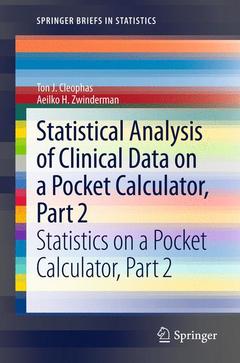Description
Statistical Analysis of Clinical Data on a Pocket Calculator, Part 2, 2012
Statistics on a Pocket Calculator, Part 2
SpringerBriefs in Statistics Series
Authors: Cleophas Ton J., Zwinderman Aeilko H.
Language: English
Subjects for Statistical Analysis of Clinical Data on a Pocket...:
52.70 €
In Print (Delivery period: 15 days).
Add to cart78 p. · 15.5x23.5 cm · Paperback
Description
/li>Contents
/li>Comment
/li>
The first part of this title contained all statistical tests relevant to starting clinical investigations, and included tests for continuous and binary data, power, sample size, multiple testing, variability, confounding, interaction, and reliability. The current part 2 of this title reviews methods for handling missing data, manipulated data, multiple confounders, predictions beyond observation, uncertainty of diagnostic tests, and the problems of outliers. Also robust tests, non-linear modeling , goodness of fit testing, Bhatacharya models, item response modeling, superiority testing, variability testing, binary partitioning for CART (classification and regression tree) methods, meta-analysis, and simple tests for incident analysis and unexpected observations at the workplace and reviewed.
Each test method is reported together with (1) a data example from practice, (2) all steps to be taken using a scientific pocket calculator, and (3) the main results and their interpretation. Although several of the described methods can also be carried out with the help of statistical software, the latter procedure will be considerably slower.
Both part 1 and 2 of this title consist of a minimum of text and this will enhance the process of mastering the methods. Yet the authors recommend that for a better understanding of the test procedures the books be used together with the same authors' textbook "Statistics Applied to Clinical Studies" 5th edition edited 2012, by Springer Dordrecht Netherlands. More complex data files like data files with multiple treatment modalities or multiple predictor variables can not be analyzed with a pocket calculator. We recommend that the small books "SPSS for starters", Part 1 and 2 (Springer, Dordrecht, 2010, and 2012) from the same authors be used as a complementary help for the readers' benefit.
These books may interest you

SPSS for Starters, Part 2 52.70 €



